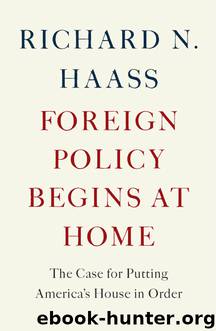Foreign Policy Begins at Home by Richard N. Haass

Author:Richard N. Haass [Haass, Richard N.]
Language: eng
Format: epub
ISBN: 9780465065967
Publisher: Basic Books
Integration
Integration is the fourth and final contender for a foreign policy doctrine. Unlike containment, which was about limiting the reach of selected countries, integration is about bringing them in, to make them a part of regional and global arrangements. Integration aims to develop rules and institutions to govern international relations and persuade as many governments as possible to see that these rules are followed and shared objectives are realized. As is the case with democracy promotion, integration represents a “positive” approach to foreign policy, in that it emphasizes a set of objectives to be created rather than frustrated.1
But at its core, integration is fundamentally different from democracy promotion. Democracy promotion seeks to change the internal nature of other countries, out of both principle and the belief that democracies will behave better beyond their borders. Integration, by contrast, focuses mostly on what states do beyond their borders. It is a foreign policy that seeks to influence the foreign policies of other countries. Indeed, integration is premised on the idea that international cooperation is possible between democracies and governments that sit on top of relatively closed political and economic systems. The US ability to regulate competition and avoid conflict with the Soviet Union during the Cold War was one example, as is today’s US-China relationship. So, too, were Israel’s peace with authoritarian Egypt and its peace with the Kingdom of Jordan.
Integration was the implicit underpinning of George H. W. Bush’s call for the creation of a “New World Order,” an objective for a more cooperative era of relations articulated in the wake of both the Cold War and the successful international collaboration that ousted Saddam Hussein and his army from Kuwait. Elements of integration could be observed in both the Clinton era (such as NAFTA, the US-Canada-Mexico trade deal) and to a lesser extent George W. Bush (global counterterrorism arrangements). Integration enjoyed something of a renaissance in the initial years of the Obama administration; it can be found in the effort to engage broadly with China, “reset” relations with Russia, create a global mechanism to slow climate change, establish a framework for expanded ties with Brazil, and advocate for India gaining a permanent seat in the UN Security Council. Integration is both the argument for and the reflection of both China and Russia’s being members of the World Trade Organization.
Integration is highly relevant to the US relationship with China, arguably the most important bilateral relationship now and for the foreseeable future. It remains very much in the interest of the United States and the world that China be integrated into regional and global arrangements to manage the economy, limit climate change, and combat the proliferation of weapons of mass destruction and the means to deliver them long distances. China’s help is needed if Korea is ever to be unified peacefully, Iran is to be prevented from gaining nuclear weapons, and Pakistan is to change its ways and not fail. Integration also provides a rationale for the US relationship with China now that
Download
This site does not store any files on its server. We only index and link to content provided by other sites. Please contact the content providers to delete copyright contents if any and email us, we'll remove relevant links or contents immediately.
| Arms Control | Diplomacy |
| Security | Trades & Tariffs |
| Treaties | African |
| Asian | Australian & Oceanian |
| Canadian | Caribbean & Latin American |
| European | Middle Eastern |
| Russian & Former Soviet Union |
The Secret History by Donna Tartt(18852)
The Social Justice Warrior Handbook by Lisa De Pasquale(12143)
Thirteen Reasons Why by Jay Asher(8800)
This Is How You Lose Her by Junot Diaz(6796)
Weapons of Math Destruction by Cathy O'Neil(6148)
Zero to One by Peter Thiel(5690)
Beartown by Fredrik Backman(5600)
The Myth of the Strong Leader by Archie Brown(5427)
The Fire Next Time by James Baldwin(5250)
How Democracies Die by Steven Levitsky & Daniel Ziblatt(5129)
Promise Me, Dad by Joe Biden(5088)
Stone's Rules by Roger Stone(5027)
A Higher Loyalty: Truth, Lies, and Leadership by James Comey(4846)
100 Deadly Skills by Clint Emerson(4843)
Rise and Kill First by Ronen Bergman(4705)
Secrecy World by Jake Bernstein(4651)
The David Icke Guide to the Global Conspiracy (and how to end it) by David Icke(4628)
The Farm by Tom Rob Smith(4439)
The Doomsday Machine by Daniel Ellsberg(4419)
